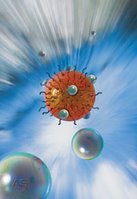'Nanorust' cleans arsenic from drinking water, Tiny tech promises 'no-energy' solution for global problem.
The new technique is described in the Nov. 10 issue of Science magazine.
CBEN's technology is based on a newly discovered magnetic interaction that takes place between particles of rust that are smaller than viruses.
"Magnetic particles this small were thought to only interact with a strong magnetic field," Colvin said. "Because we had just figured out how to make these particles in different sizes, we decided to study just how big of magnetic field we needed to pull the particles out of suspension. We were surprised to find that we didn't need large electromagnets to move our nanoparticles, and that in some cases hand-held magnets could do the trick."
The experiments involved suspending pure samples of uniform-sized iron oxide particles in water. A magnetic field was used to pull the particles to out of solution, leaving only the purified water. Colvin's team measured the tiny particles after they were removed from the water and ruled out the most obvious explanation: the particles were not clumping together after being tractored by the magnetic field.
Colvin, professor of chemistry, said the experimental evidence instead points to a magnetic interaction between the nanoparticles themselves.
Co-author Doug Natelson explains, "As particle size is reduced the force on the particles does drop rapidly, and the old models were correct in predicting that very big magnetic fields would be needed to move these particles.
"In this case, it turns out that the nanoparticles actually exert forces on each other," said Natelson, associate professor of physics and astronomy and in electrical and computer engineering. "So, once the hand-held magnets start gently pulling on a few nanoparticles and get things going, the nanoparticles effectively work together to pull themselves out of the water."
Colvin said, "It's yet another example of the unique sorts of interactions we see at the nanoscale."
Because iron is well known for its ability to bind arsenic, Colvin's group repeated the experiments in arsenic-contaminated water and found that the particles would reduce the amount of arsenic in contaminated water to levels well below the EPA's threshold for U.S. drinking water.
Colvin's group has been collaborating with researchers from Rice Professor Mason Tomson's group in civil and environmental engineering to further develop the technology for arsenic remediation. Colvin said Tomson's preliminary calculations indicate the method could be practical for settings where traditional water treatment technologies are not possible. Because the starting materials for generating the nanorust are inexpensive, she said the cost of the materials could be quite low if manufacturing methods are scaled up. In addition, Colvin's graduate student, Cafer Yavuz, has been working for several months to refine a method that villagers in the developing world could use to prepare the iron oxide nanoparticles. The primary raw materials are rust and fatty acids, which can be obtained from olive oil or coconut oil, Colvin said. ###
Additional co-authors include research scientist Amy Kan, postdoctoral research associate William Yu and graduate students John Mayo, Arjun Prakash, Joshua Falkner, Sujin Yean, Lili Cong and Heather Shipley.
The research is sponsored by the National Science Foundation.
Contact: Jade Boyd jadeboyd@rice.edu 713-348-6778 Rice University
Technorati Tags: nanofibers or Nanoscientists and Nano or Nanotechnology and nanoparticles or Nanotech and nanotubes or nanochemistry and nanoscale or nanowires and Nanocantilevers or nanometrology and nanostructure or Center for Biological and Environmental Nanotechnology and arsenic poisoning or contaminated water
















1 comment:
I've personally researched and learned that arsenic removal from one's source water can be a difficult task without the right water filtration technology. I've come across an impressive option called the ArsenicMaster whole house arsenic water filtration system which will completely remove or significantly reduce the arsenic from one's source water. For those that are interested, I know that the company Vitasalus at http://www.vitasalus.com or http://www.equinox-products.com sells the ArsenicMaster Whole Home Arsenic Water Filter System for a fraction of the cost of other companies.
Post a Comment